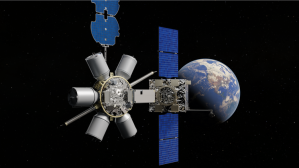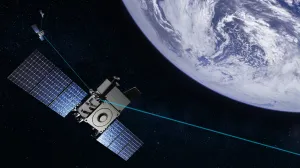Space Force launches new effort to share unclassified threat data with commercial industry

COLORADO SPRINGS, Colo. — The Space Force’s acquisition arm is now able to share unclassified information about on-orbit threats with hundreds of commercial space companies under a new program called “Orbital Watch,” the service announced Tuesday.
Space Systems Command’s Front Door — which facilitates the Space Force’s collaboration with commercial industry — launched the Orbital Watch effort March 21 by releasing “an unclassified threat fact sheet” to over 900 companies registered with the organization, according to a press release. The program intends to disseminate critical data to commercial providers so they can improve the designs of their systems against modern threats.
“Front Door is moving out on this essential effort,” Victor Vigliotti, director of Front Door, said in a statement. “We are providing our commercial partners the information needed to increase system resilience and mitigate threats, both of which are foundational to the successful integration of commercial space capabilities in national security space architectures.”
Last year, the Pentagon and Space Force each released strategies outlining how they planned to improve collaboration with the rapidly growing commercial space industry. While the Pentagon’s strategy outlined department-wide guidance on policy and procedures, the Space Force’s document focused on service-specific use cases for commercial technology integration.
Both strategies called for the establishment of processes that allow the Defense Department to share threat information — such as space domain awareness and cybersecurity — with companies in order to mitigate risk to commercial vendors working with the military.
“This initiative is in direct alignment with the DoD Commercial Space Integration Strategy and the USSF Commercial Space Strategy, as well as congressional guidance,” Col. Richard Kniseley, senior materiel leader of SSC’s Commercial Space Office, said in a statement. “Front Door has vast ties to industry right now and a clear mechanism for communicating threat information. The goal is sharing threat information in a timely manner, and Front Door is well equipped to do that.”
According to the Space Force, Orbital Watch will roll out in phases. The initial operating capability — or “beta phase” — will focus on releasing unclassified assessments of evolving risks in the space domain on a quarterly basis. That cadence will increase as SSC’s Front Door identifies and consolidates more sources of unclassified threat data.
“The full operational capability phase of Orbital Watch will introduce a secure ‘Commercial Portal,’ enabling two-way threat information sharing between the government and commercial space providers deemed critical to Space Force operations,” a service press release noted.
The Orbital Watch program comes as the Space Force continues exploring how to better integrate commercial capabilities into its warfighting architectures and operations. Notably, SSC is in the midst of reviewing its portfolio of legacy programs to understand if some of its requirements could be fulfilled using technology developed by industry.
The review was initiated in March by Maj. Gen. Stephen Purdy, military deputy for the Office of the Assistant Secretary of the Air Force for Space Acquisition and Integration, and began with an acquisition decision memorandum focused on analyzing commercial options for new space domain awareness capabilities that cover geosynchronous orbit.
However, SSC commander Lt. Gen. Phillip Garrant said the effort has expanded to every major acquisition program under the Space Force, and that program managers are now considering how they could meet their requirements with commercial capabilities.
“It’s aligned with the pivot we’re trying to make, and everything’s on the table — from [the Deep Space Advanced Radar Capability], which is a major construction project around the world, to satellite systems,” Garrant told reporters Tuesday on the sidelines of Space Symposium. “Nobody got a pass, everybody has to do this excursion of, could I start over and meet my requirements commercially?”
Garrant added that he hasn’t seen any initial results from program managers, but emphasized the review is much more than an academic exercise.
The Space Force has been clear about which mission sets can lean heavily on commercial technology — such as satellite communications and imagery — and others that will need to remain within the government’s purview, including defensive and offensive space control. However, Garrant noted that other mission areas are more difficult to delineate between what commercial can and can’t bring.
“Flying a GPS satellite could be commercial, [but] application of regional military power is probably inherently governmental,” he said. “So, it depends. But there are specific missions that won’t ever be commercial.”






